Understanding the Importance of Biodiversity
Biodiversity is crucial not merely for ecological reasons but for human survival. It underpins ecosystem services that directly affect our daily lives.
Why Biodiversity Matters
Biodiversity ensures ecosystem stability. High biodiversity allows ecosystems to recover from disturbances such as natural disasters. According to the UN Convention on Biological Diversity, diverse species perform various functions essential for ecosystem health.
Biodiversity supports agriculture. Different species contribute such as:
- pollination
- pest control
- soil fertility
For example, bees pollinate many crops, a job valued at billions of dollars annually by the Food and Agriculture Organization (FAO).
Biodiversity contributes to medical discoveries. Many medications are derived from plant and animal species. Aspirin, originally derived from willow tree bark, highlights how nature influences modern medicine.
The Components of Biodiversity
The components of biodiversity include species diversity, genetic diversity, and ecosystem diversity. Species diversity refers to the variety of species within a habitat. For instance, rainforests and coral reefs are noted for high species diversity.
Genetic diversity is the variation within a species’ genes. More genetic diversity means species have a better chance of adapting to changes. For example, crops with diverse genes resist diseases more effectively, ensuring food security.
Ecosystem diversity encompasses different ecosystems like forests, deserts, and oceans. Each ecosystem provides unique services. Forests regulate climate by absorbing CO2, oceans support marine life and influence weather patterns, and deserts play roles in water filtration and soil formation.
The Benefits of Biodiversity to Ecosystems

Biodiversity offers invaluable benefits that sustain ecosystems. These benefits ensure the efficient functioning of our natural world.
Pollination and Plant Growth
Pollination performed by diverse species like bees, butterflies, and birds contributes to plant growth and crop production.
Over 75% of the world’s food crops rely on animal pollination, per the Food and Agriculture Organization (FAO). Various plants also depend on specific pollinators for reproduction, promoting genetic diversity.
Robust plant growth helps stabilize soil, reduces erosion, and enhances carbon sequestration, crucial for mitigating climate change.
Waste Decomposition and Water Purification
Many microorganisms, fungi, and invertebrates break down organic waste, recycling nutrients back into the soil. This decomposition process improves soil fertility, which supports plant growth and agricultural productivity.
Wetlands, forests, and grasslands, comprising diverse species, filter pollutants from water. Ecosystems with high biodiversity naturally purify water, maintaining its quality for human use and aquatic life.
Clean water availability relies on these natural processes, which reduce the need for costly artificial purification systems.
These ecosystem benefits are pivotal, reinforcing the need to conserve biodiversity.
Human Dependence on Biodiversity
Human survival and quality of life rely heavily on biodiversity. It underpins our food sources, medicinal needs, and economic stability.
Food Sources and Medicinal Resources
Biodiversity provides a variety of food sources necessary for nutrition. Diverse species, such as crops and livestock, ensure food security and a balanced diet. For example, bees are essential for pollinating plants, which directly affects fruit, vegetable, and nut production.
Medicinal resources also originate from a rich biodiversity. Many modern medicines, like aspirin from willow bark and quinine from the cinchona tree, come from plants. Preserving diverse ecosystems could lead to discoveries of new drugs essential for treating diseases.
Economic Benefits of Ecosystem Services
- Ecosystem services generated by biodiversity have substantial economic benefits.
- Pollination by insects, pest control by birds, and water purification by wetlands contribute significantly to agriculture and fisheries. For instance, crop pollination by insects like bees is valued at approximately $235 billion annually.
- Carbon sequestration by forests and soil stabilization by vegetation mitigate climate change, reducing costs related to natural disasters.
- Wetlands’ water purification can save billions in water treatment expenses, emphasizing the economic value of maintaining healthy ecosystems.
Biodiversity Threats and Challenges
Biodiversity faces numerous threats and challenges that significantly impact ecosystems and human well-being. Let’s dive into two critical issues.
Habitat Loss and Climate Change
Habitat loss, often due to deforestation and urbanization, remains one of the primary threats to biodiversity. About 17% of the Amazon rainforest, for example, has been lost in the past 50 years.
Many species lose their homes and food sources, leading to population declines and extinctions. Climate change compounds these problems by altering weather patterns, impacting species’ ability to survive.
Rising temperatures and shifting precipitation affect ecosystems globally. Coral reefs, for instance, experience bleaching due to thermal stress, and polar bears struggle with shrinking ice habitats. Species unable to adapt quickly enough face increased extinction risk.
Overexploitation and Pollution
Overexploitation involves harvesting species at rates faster than they can reproduce. Overfishing has depleted 90% of large fish populations. Hunting and logging also contribute to species decline, making it difficult for ecosystems to maintain balance.
Pollution poses another significant threat. Chemicals from industrial activities contaminate water bodies, while plastic waste disrupts marine life. Pesticides and fertilizers, used in agriculture, damage non-target species and reduce soil health, further harming biodiversity.
Conservation Efforts and Global Initiatives
Various conservation efforts and global initiatives play a crucial role in preserving biodiversity. These efforts involve multiple strategies and actions aimed at protecting ecosystems and species.
Protected Areas and Wildlife Preservation
Protected areas serve as vital refuges for wildlife. National parks, wildlife reserves, and marine sanctuaries help safeguard habitats from human interference.
According to the International Union for Conservation of Nature (IUCN), over 15% of the Earth’s terrestrial surface is under protection. These areas provide safe zones for endangered species like the Bengal tiger and the black rhinoceros, allowing them to thrive without the pressures of poaching and habitat destruction.
In addition to national efforts, various organizations work on protecting critical habitats globally.
For example, the World Wildlife Fund (WWF) focuses on key biodiversity hotspots, implementing measures like anti-poaching patrols and community conservation programs.
By working with local communities, these efforts also promote sustainable livelihoods while preserving biodiversity.
International Agreements and Local Actions
International agreements form a significant part of global initiatives. The Convention on Biological Diversity (CBD), signed by 196 countries, sets global goals for biodiversity conservation.
The Aichi Biodiversity Targets, part of the CBD’s strategic plan, aim to address the underlying causes of biodiversity loss by 2020, though ongoing efforts continue to push these goals forward.
Local actions amplify the impact of international agreements. For instance, countries adopt national biodiversity strategies in alignment with global targets.
Costa Rica’s Payment for Environmental Services (PES) program pays landowners to manage their land sustainably, resulting in a reforestation increase and biodiversity boost.
Similarly, Australia’s Bushcare program engages communities in preserving local habitats through volunteer activities like planting native species and controlling invasive plants.
Together, these efforts form a multilayered approach to combating biodiversity loss, ensuring that conservation happens at every level, from local grassroots initiatives to international policy frameworks.
 Williamond Hougherth - Founder of Green Commerce Haven
Williamond Hougherth is a visionary entrepreneur and environmental advocate with a deep passion for sustainable business practices. As the founder of Green Commerce Haven, Williamond has dedicated his career to promoting eco-friendly initiatives and supporting the growth of green startups. His extensive knowledge in green marketing strategies and organic products has made him a trusted voice in the eco-commerce industry. Through Green Commerce Haven, Williamond provides valuable insights on eco news, green tourism, and sustainable living, helping businesses and consumers alike make informed decisions that contribute to a healthier planet.
Williamond Hougherth - Founder of Green Commerce Haven
Williamond Hougherth is a visionary entrepreneur and environmental advocate with a deep passion for sustainable business practices. As the founder of Green Commerce Haven, Williamond has dedicated his career to promoting eco-friendly initiatives and supporting the growth of green startups. His extensive knowledge in green marketing strategies and organic products has made him a trusted voice in the eco-commerce industry. Through Green Commerce Haven, Williamond provides valuable insights on eco news, green tourism, and sustainable living, helping businesses and consumers alike make informed decisions that contribute to a healthier planet.
